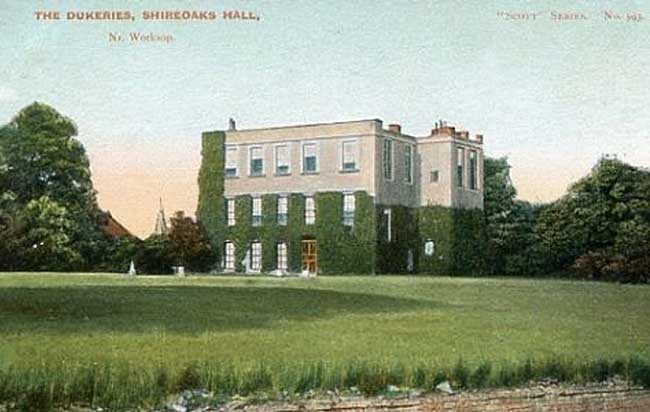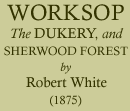< Previous | Contents | Next >
Hamlets in the parish of Worksop
Shireoaks

Shireoaks Hall, c.1910. Shireoaks Hall was built c.1600 by the Hewitt family, altered c.1700, partly demolished and gutted in the early 19th century and patched up subsequently.
SHIREOAKS, no doubt, derived its name from a group of oak trees which stood at the junction of the three counties of Derby, Nottingham, and York. The survivor of these is specially described by Evelyn in his "Sylva," as a tree of remarkable size. Its site was not at the point marked in the Ordnance and other modern maps, to the west of Steetley, but near the corner of Shireoaks Park, where the road formerly branched off to that village from the Steetley lane. It is here, therefore, that we must look for the true ancient point of convergence of the counties.
This fact appears to be conclusively established by the survey of John Harrison, made in 1636, where, describing the fields of the Steetley Farm, he not only tells us that those in this direction were bounded on the north by a part of Yorkshire, but expressly states that "the last field towards Holm Car, ‘called Shireoake field,’ abutteth upon Shireoake towards the East."
The Prior of Worksop obtained a charter of free warren, 14 Edward I., among other places in "Shiraks," which is there described as in "Yorkshere," i.e. no doubt, the upper part of the park and Scratta, where the sporting ground would be. This entirely agrees with the survey above-named.
The manor or grange of Shireoaks formed part of the possessions of the Priory of Worksop, to which it was given by Emma de Lovetot, the founder’s wife, and her gift was confirmed and increased by her son Richard.
In 1458, the Prior and convent leased their grange or manor here, to Henry Ellis Esq., and Dame Luce, his wife, for the term of twelve years, a facsimile of which lease is here given; the original lease was in the possession of the late Richard Rawlinson, L. L. D., F.R.S., and is now in the Bodleian Library.
After the dissolution of the Priory, King Henry VIII, in the 38th year of his reign, A.D., 1546, granted the manor or, grange of "Sherokes," in the hamlet of Sherokes, in the parish of Workesoppe, in the county of Nottingham, to Robert Thornhill and Hugh Thornhill, from whom it passed to the family of Hewet by purchase.
The Hewets were a family of considerable antiquity at the neighbouring villages of Wales and Killamarsh: several of them acquired great wealth as cloth-workers in London, about the time of Queen Elizabeth. Of these was Sir William Hewet, Lord Mayor in 1559-60; who, through his only child, a daughter, became the ancestor of the Osbornes, afterwards Dukes of Leeds, and greatly enriched and elevated that family, conferring on them, among other estates, property in Harthill and Wales.
It seems however, to have been Thomas, the brother of Sir William, also a London merchant, who was the purchaser of the Shireoaks estate, since, by his will, made in 1575, he leaves this property to his son Henry.
Henry appears to have married a daughter of a distant relative, another Sir W. Hewet, of Killamarsh and London, a rich merchant, who died in 1599, and was buried in St. Paul’s Cathedral, where a pompous tomb and epitaph were placed to his memory; while some wit of the day supplied another epitaph, which has been preserved, and being at once both very brief and caustic it may be worth repeating
"Here lyes rich Hewet, a gentleman of note:
For why? He gave three owls in his coate.
Ye see he is buried in the church of Saint Paul:
He was wise, because rich, and now you know all."
Henry Hewet was the father of the first Sir Thomas Hewet of Shireoaks, who was high sheriff of the county of Nottingham in the third year of Charles I., and died in 1660, and was buried at Worksop. Sir Thomas had a numerous family, all of whom, however, he survived, when the property, it seems, came to his great-nephew, another Sir Thomas Hewet, who was born September 9, 1656, and died April 9, 1726, and was buried at Wales.
This latter Sir Thomas spent much of his early life abroad, where he seems to have acquired great taste in architecture and landscape gardening, and it is intimated that he was rather loose in his opinions on religious subjects. He was Surveyor-General of Woods to King William III, and of Works to George the 1st. He appears to have made very extensive alterations and improvements at Shireoaks, having rebuilt much of the house, formed several fine avenues, cascades, and fishponds, &c., as well as having erected a costly banqueting house in the wood of Scratta. He seems also to have formed or enlarged the deer-park, and altogether to have made Shireoaks Hall a very beautiful residence. Some faint traces of its ancient glory are even yet resting upon it, though it is now reduced to the condition of a farmhouse, and its park enclosed for cultivation.
Sir Thomas Hewet had a daughter, his only child, whom he disinherited in consequence of her having so tradition says, married a gipsy or fortune-teller. His estates he left, in the first place, to his godson, John Thornhaugh, Esq., of Osberton, for his life, who, upon coming into possession of the property assumed the surname of Hewet; afterwards, to the eldest surviving son of his distant relative, the Rev. John Hewet, the rector of Harthill. Accordingly, upon the death of Mr. Thornhaugh Hewet, Shireoaks and other property came to another Rev. John Hewet, who had already succeeded his father in the rectory of Harthill.
These Hewets, three of whom, in lineal descent, held that comfortable benefice for the long period of 117 years, appear to have been derived from a branch of family which had settled at Eccles, in Lancashire, though their exact connexion with the Wales and Killamarsh stock is not quite apparent. A direct ancestor of the rectors was a Rev. Dr. John Hewet, a very popular divine in London in the days of Charles the 1st, and one of the chaplains of that king. He was a devoted Royalist, and lost his life for holding correspondence with the exiled family, having been beheaded on Tower Hill, June 8, 1659. The late Mr. Hewet, of Shireoaks, was the fourth in descent from this divine.
Mr. Hewet was never married: he died December 30, 1811, at the advanced age of eighty-nine years, at Shireoaks Hall, where he had resided from the time that he came into possession of the property, and was buried in the chapel which he had built and endowed at the hamlet. About a year before his death he conveyed by deed of gift, reserving a life interest to himself, his estates to John Wheatley, the younger son of his niece. Wheatley never came into possession of them, having immediately sold the reversion to Mr. Vincent Eyre, the agent of Charles, Duke of Norfolk, to whom Shireoaks was then conveyed. With the successor of that nobleman, Shireoaks continued till it was sold in 1842, together with the Worksop manor estate, to the then Duke of Newcastle, with whose representatives it still continues.
In the farmyard attached to the Hall there still exist some interesting remains of the Priory Grange, in the form of curious ancient barns and stables, and especially a portion of the house, having a beautiful three-light window of the 14th century.
In May 1854, the late Duke of Newcastle commenced sinking at Shireoaks two shafts, and on February 1st, 1859, at a depth of 510 yards, the "Top Hard Coal," three feet ten inches thick was arrived at, as the result of five years of single-handed perseverance on the part of the late lamented Duke of Newcastle.
The coal was found to be of very superior quality for steam purposes; a medal was awarded to the noble Duke at the Exhibition of 1862, for proving the existence of a large coal field under the Permian measures, and the coal was placed on the Royal Navy list. After working the colliery successfully for five years, during which a model row of colliers’ houses were built, the undertaking was sold and leased to the Shireoaks Colliery Company, whose extensive works have quite altered the former quiet and peaceful features of the village, in place of which activity now prevails.
With the view of providing for the spiritual wants of the increased population of the village, the late Duke of Newcastle built the present church; the foundation-stone was laid by His Royal Highness the Prince of Wales, October 18th, 1861, and it was opened October 15th, 1863.
The church is of English Gothic of the 14th century, and consists of a clerestoried nave, north and south aisles, an apsidal chancel, and a lofty tower surmounted by a broached spire. The tower occupies central position between the nave and chancel, and is flanked by an organ recess on the north side, and by a vestry on the south. It is supported on massive piers and pointed arches of considerable height; the latter being deeply moulded and springing from clustered marble shafts on richly-carved corbels, contribute in no slight degree to the general effect of the interior.
The extreme length of the church is 108 feet, and the breadth 46 feet. The windows throughout are of geometric patterns; they have traceried heads, and are surmounted by a hood mould terminating in carved bosses. The roofs are of good pitch and are open timbered, the flat spaces between the spars been filled with ornamental stencilling; painted decoration is also applied to the walls in the form of inscriptions.
The church is fitted up with open benches, those in he chancel together with the communion table and lectern being of oak and of elaborate detail. The walls throughout are built externally and internally of Steetley stone.
The reredos is of alabaster, inlaid with Italian marbles and Derbyshire spar. It is divided into three compartments, surmounted by canopies, supported on slender pillars richly capped. The centre division contains a basso relievo, the crucifixion of our Saviour; and the other two, saints and martyrs in adoration. In niches dividing the subjects are figures of the four Evangelists, and below, in quartrefoils, are the emblems. On the pedestals above there are represented angels, in attitudes of praise and adoration. The spandrils of the canopies are in Derbyshire spar and Italian marble, whilst the canopies of the figures are inlaid with mosaic work.
